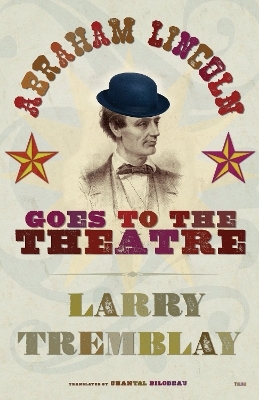
Abraham Lincoln Goes to the Theatre
Seiten
2010
Talonbooks (Verlag)
978-0-88922-649-4 (ISBN)
Talonbooks (Verlag)
978-0-88922-649-4 (ISBN)
- Titel z.Zt. nicht lieferbar
- Versandkostenfrei innerhalb Deutschlands
- Auch auf Rechnung
- Verfügbarkeit in der Filiale vor Ort prüfen
- Artikel merken
A feared but much-admired director hires two actors to re-enact the assassination of Abraham Lincoln. Cast of 3 men.
John Wilkes Booth assassinated Abraham Lincoln at Ford's Theatre in Washington, D.C. Inside that theater today, Ranger Powell of the U.S. Parks Service takes crowds of tourists, the curious and the ghoulish through a step-by-step description of the assassination. Underneath the box where Lincoln was shot, he describes the plot of the comedy Lincoln watched that night, Our American Cousin, as being "kind of like the Beverly Hillbillies." Scratch the surface of any story and underneath you will find layer upon layer of fiction masquerading as fact. The play's main character, Mark Killman--a feared but much admired director--draws inspiration from Abraham Lincoln's assassination to stage the schizophrenia of America. He hires two actors to play Laurel and Hardy. Both are to re-enact the assassination, while he himself plays the iconic role of Abraham Lincoln as a wax figure. The script is frequently self-referential, building on each of these "retakes" with further allusions to itself, telling the same story many times over in different voices from different points of view.
Tremblay quite explicitly stages elements of literary theory with this play, including references to Jean Baudrillard's concept of the simulacra and the "desert of the real," concepts first popularized by the movie The Matrix--the idea that in our post-modern world, the imitator has become more relevant than the imitated, and that the virtual worlds we construct are becoming more "real" to us than the real world. Absurd, hilarious and haunting, Abraham Lincoln Goes to the Theatre is an unforgettable mystery that asks the question: How can we ever know who we are and what is true when the world we know is shifting beneath us? Its answer is simple: John Wilkes Booth was the first American star--the actor who kidnapped reality to transform it into theater. Cast of 3 men.
John Wilkes Booth assassinated Abraham Lincoln at Ford's Theatre in Washington, D.C. Inside that theater today, Ranger Powell of the U.S. Parks Service takes crowds of tourists, the curious and the ghoulish through a step-by-step description of the assassination. Underneath the box where Lincoln was shot, he describes the plot of the comedy Lincoln watched that night, Our American Cousin, as being "kind of like the Beverly Hillbillies." Scratch the surface of any story and underneath you will find layer upon layer of fiction masquerading as fact. The play's main character, Mark Killman--a feared but much admired director--draws inspiration from Abraham Lincoln's assassination to stage the schizophrenia of America. He hires two actors to play Laurel and Hardy. Both are to re-enact the assassination, while he himself plays the iconic role of Abraham Lincoln as a wax figure. The script is frequently self-referential, building on each of these "retakes" with further allusions to itself, telling the same story many times over in different voices from different points of view.
Tremblay quite explicitly stages elements of literary theory with this play, including references to Jean Baudrillard's concept of the simulacra and the "desert of the real," concepts first popularized by the movie The Matrix--the idea that in our post-modern world, the imitator has become more relevant than the imitated, and that the virtual worlds we construct are becoming more "real" to us than the real world. Absurd, hilarious and haunting, Abraham Lincoln Goes to the Theatre is an unforgettable mystery that asks the question: How can we ever know who we are and what is true when the world we know is shifting beneath us? Its answer is simple: John Wilkes Booth was the first American star--the actor who kidnapped reality to transform it into theater. Cast of 3 men.
Larry Tremblay Larry Tremblay is a writer, director, actor and specialist in Kathakali, an elaborate dance theatre form which he has studied on numerous trips to India. He has published twenty books as a playwright, poet, novelist and essayist. The recent publication of Talking Bodies (Talonbooks, 2001) brought together four of his plays in English translation. Chantal Bilodeau Chantal Bilodeau is a New York-based playwright and translator originally from Montreal. Her translations include plays by Mohamed Kacimi (Algeria), Koffi Kwahule (Ivory Coast), Etienne Lepage (Quebec) and Larry Tremblay (Quebec). She is currently at work on a six-play cycle, titled The Arctic Cycle.
| Erscheint lt. Verlag | 11.11.2010 |
|---|---|
| Übersetzer | Chantal Bilodeau |
| Zusatzinfo | Illustrations |
| Sprache | englisch |
| Maße | 139 x 215 mm |
| Gewicht | 141 g |
| Themenwelt | Literatur ► Comic / Humor / Manga |
| Literatur ► Lyrik / Dramatik ► Dramatik / Theater | |
| Geisteswissenschaften ► Philosophie ► Philosophie des Mittelalters | |
| Sozialwissenschaften ► Politik / Verwaltung | |
| ISBN-10 | 0-88922-649-0 / 0889226490 |
| ISBN-13 | 978-0-88922-649-4 / 9780889226494 |
| Zustand | Neuware |
| Haben Sie eine Frage zum Produkt? |
Mehr entdecken
aus dem Bereich
aus dem Bereich
Der Tragödie erster und zweiter Teil. Urfaust
Buch | Hardcover (2021)
C.H.Beck (Verlag)
10,00 €
Kleist, Heinrich von – Deutsch-Lektüre, Deutsche Klassiker der …
Buch | Softcover (2024)
Reclam, Philipp (Verlag)
7,40 €


